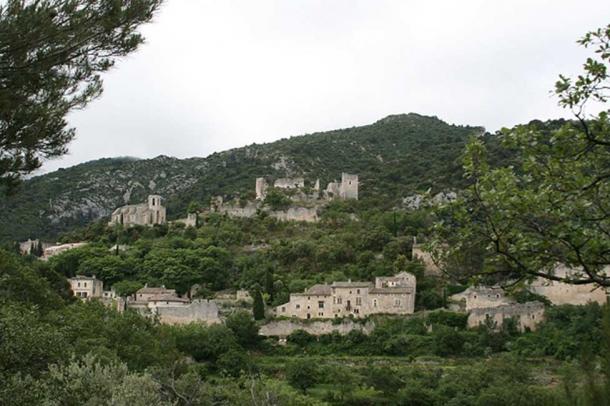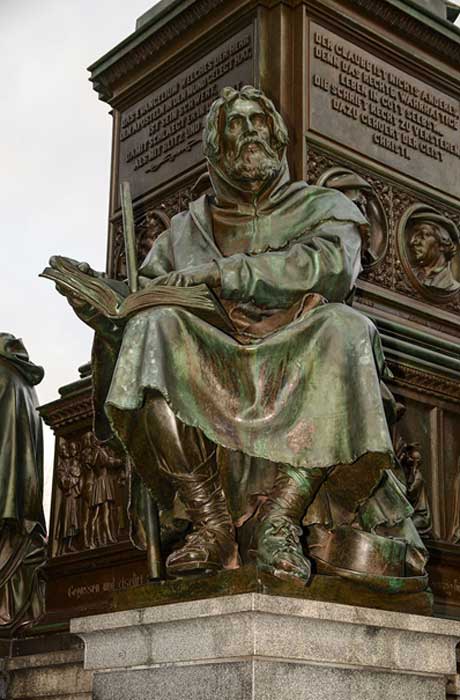
The Medieval Ruins of Oppède Le Vieux, Home to an Antipope and Shelter from the Nazis
Oppède Le Vieux is a small town in France, which is best known for its Medieval château, or castle, which today lies in ruins. The town was abandoned several centuries ago, when its inhabitants left for a new area where they could farm more productively. Although the town lies in ruins today, it has a colorful history behind it, involving an antipope and a group of artists fleeing from the Nazis during the Second World War.
Oppède Le Vieux is perched on the northern side of the Luberon, a massif in central Provence, in the south of France. It is built against the part of the massif known as the ‘Petit Luberon’, which means ‘Little Luberon’, and can be found in the Vaucluse department of the Provence-Alpes-Côte d'Azur region.

A view of Oppède Le Vieux. Photo source: (CC BY-SA 3.0)
Oppède Le Vieux is said to date back to the 12 th century. During this time, the town was home to a farming community, and its most prominent structures were its church and its château. The church is known as the Collegiale Notre-Dame d'Alidon, and is located high above the town. Within the walls of this ancient structure are a great number of frescoes, though many of these are either faded or ruined. It has been reported that at the moment, the church is being restored.
- The conspiracy theories of Bérenger Saunière and Rennes-le-Château
- Cairn de Barnenez: One of the Oldest Structures in the World
- A Walk Amongst the Petroglyphs of Galicia: Prehistoric Designs Trace Life and Times of Bronze Age Europeans
As for the château, it was once the property of the counts of Toulouse. Then, during the 13 th century, the structure fell into the hands of the papacy. During the Western Schism, which took place between the second half of the 14 th century and the first half of the following, the castle of Oppède Le Vieux was the home of Antipope Benedict XIII for a period of time. An Antipope is an individual in opposition to the one who is generally seen as the legitimately elected Pope.

Ruins of the Castle of Oppède le Vieux, Vaucluse, France (Public Domain)
When the antipope was forced to flee from the town, he, according to one source “’flew off’ from the very top by way of an arched postern opening onto the empty space below, borne, it's said, by the devil himself.” The next famous / infamous resident of the château was Jean Maynier, Baron of Oppède. The baron is said to have made the château his headquarters, from which he waged war against the Waldensians, a Christian movement founded by Peter Waldo in the 12 th century. During this war, 11 villages are said to have been destroyed by the baron’s men.

Statue of Peter Waldo (CC BY 3.0)
Despite thriving during the Middle Ages, Oppède Le Vieux was later abandoned after the 16 th century. It has been claimed that as it was peaceful during that time, most of the town’s inhabitants decided to move down into the valley, which had land better suited for agricultural purposes. A new town, known as Oppède les Poulivets, was founded, and the old one was left abandoned for the next couple of centuries.
- Le Chene Chapelle: The Ancient Oak Tree Chapel as Old As France Itself
- Medieval Mont St-Michel: The Sacred Castle in the Sea
- Annecy in the French Alps has ancient origins dating back to 3100 BC
It was during the Second World War that some new life was injected into the ghost town. During this period, Oppède Le Vieux became a perfect hiding place for artists wanting to escape from the persecution of the Nazis who occupied France. This group, which included painters, writers and sculptors, were known as le Groupe d’Oppède, and was led by the architect Bernard Zehrfuss.
During the war, the Nazis unleashed a purge of art that was not useful to the German government for propaganda purposes. Museum directors and artists that refused to comply with Reich-approved art were killed or forbidden from practicing art. The Gestapo frequently made impromptu visits to the homes of artists to ensure their compliance. In response to the oppressive restrictions, many artists were forced to flee and the ruins of Oppède Le Vieux were a good hiding place.
The community of artists seeking refuge grew to about 50 strong, the most notable of whom were the sculptor François Stahly, and the artist and writer Consuelo de Saint Exupéry (the wife of Antoine de Saint Exupéry, the author of Le Petit Prince). Nevertheless, this community did not last long, and they eventually left the town. Today, Oppède Le Vieux is a tourist destination.

Medieval Church of Notre-Dame-d'Alydon d'Oppède, Vaucluse, France (CC BY-SA 3.0)
Top image: A view of Oppède Le Vieux. (Brent Pearson / Flickr)
By Wu Mingren
References
Collins, R., 2015. Oppède. [Online]
Available at: http://www.beyond.fr/villages/oppede.html
Spencer, L. J., 2016. The Ruins of Oppede-le-Vieux. [Online]
Available at: http://www.atlasobscura.com/places/the-ruins-of-oppedelevieux
www.avignon-et-provence.com, 2016. Oppède le Vieux. [Online]
Available at: http://www.avignon-et-provence.com/en/tourism-provence/oppede-vieux
www.francetravelplanner.com, 2016. Oppède-Le-Vieux, Luberon, Provence, France. [Online]
Available at: http://www.francetravelplanner.com/go/provence/luberon/oppede/index.html
www.provenceguide.co.uk, 2016. Oppède le Vieux. [Online]
Available at: http://www.provenceguide.co.uk/cultural-heritage/luberon/oppede-le-vieux/provence-PCUPAC084CDT0000219-1.html
www.provenceweb.fr, 2016. Oppède Le Vieux. [Online]
Available at: http://www.provenceweb.fr/e/vaucluse/oppede/oppede.htm















